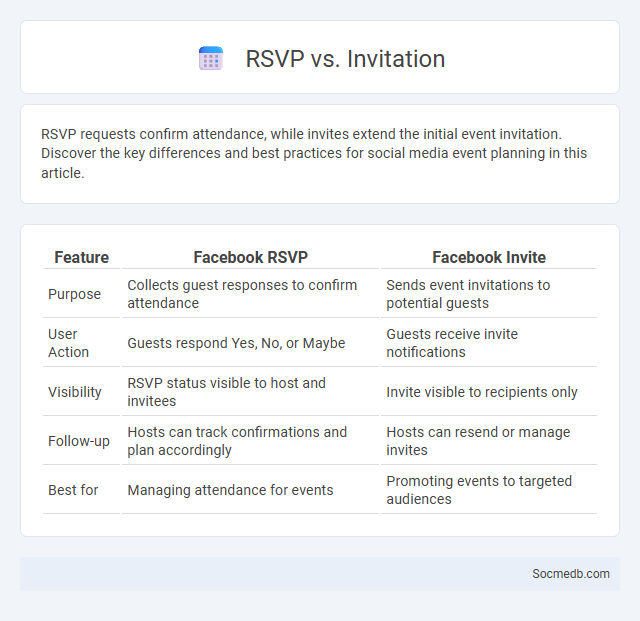
Photo illustration: RSVP vs Invite
RSVP requests confirm attendance, while invites extend the initial event invitation. Discover the key differences and best practices for social media event planning in this article.
Table of Comparison
| Feature | Facebook RSVP | Facebook Invite |
|---|---|---|
| Purpose | Collects guest responses to confirm attendance | Sends event invitations to potential guests |
| User Action | Guests respond Yes, No, or Maybe | Guests receive invite notifications |
| Visibility | RSVP status visible to host and invitees | Invite visible to recipients only |
| Follow-up | Hosts can track confirmations and plan accordingly | Hosts can resend or manage invites |
| Best for | Managing attendance for events | Promoting events to targeted audiences |
Introduction: Understanding RSVP and Invite
RSVP (Repondez s'il vous plait) is a crucial component of social media event management, enabling hosts to gauge attendance and plan accordingly. Online invitations on platforms like Facebook and Eventbrite integrate RSVP features to streamline guest responses and enhance event organization. Efficient RSVP tracking boosts engagement rates and improves the overall success of social media events.
What Does RSVP Mean?
RSVP stands for "Repondez s'il vous plait," a French phrase meaning "Please respond," commonly used in social media event invitations to confirm attendance. Your quick RSVP helps hosts manage guest lists effectively and ensures accurate planning for the event. Understanding RSVP on platforms like Facebook or Instagram streamlines your event participation and communication.
The Purpose of an Invitation
The purpose of an invitation on social media is to engage your audience meaningfully by prompting action such as attending events, joining groups, or participating in discussions. It serves as a direct communication tool that encourages interaction, fosters community building, and increases event visibility through shares and RSVPs. Crafting a clear, compelling invitation helps you maximize reach and ensures your message resonates with the intended audience.
RSVP vs Invite: Key Differences
RSVP and invite serve distinct purposes in social media event management; an invite initiates the event notification by alerting Your audience about the upcoming occasion, while an RSVP requests confirmation of attendance. Invites primarily focus on disseminating event details such as date, time, and location, whereas RSVPs gather crucial data on the number of attendees, allowing for better planning and resource allocation. Understanding these differences ensures effective communication and optimized event engagement on social platforms.
Why Is RSVP Important for Event Planning?
RSVP is crucial for event planning because it provides accurate attendee counts, enabling organizers to allocate resources effectively and manage venue capacity. Collecting RSVPs through social media platforms facilitates real-time updates and streamlined communication, reducing no-shows and last-minute changes. Precise RSVP tracking improves budgeting, catering, and staff arrangements, ensuring a smoother, well-coordinated event experience.
Common Misconceptions About RSVP and Invites
Many people mistakenly believe that RSVP means a definite confirmation, but it actually stands for "Repondez S'il Vous Plait," requesting a response whether attending or not. Assuming invites are always digital overlooks the significant impact of personalized, physical invitations that can enhance event anticipation. Your clear communication of expectations and deadlines for RSVPs ensures accurate guest counts and smooth event planning.
Best Practices for Sending Invitations
When sending social media invitations, personalize each message by including the recipient's name and a clear reason for the invitation to increase engagement rates. Use concise, friendly language and provide a direct call to action, such as clicking a link or RSVPing, to simplify the response process. Timing the invitation to align with recipients' online activity patterns enhances visibility and improves acceptance rates.
How to Request and Track RSVPs
Request RSVPs on social media by creating clear, engaging event posts with direct RSVP buttons or links to a dedicated registration page. Utilize platform-specific features like Facebook Events or Instagram Stories polls to capture responses efficiently. Track RSVPs through integrated analytics tools or third-party event management software for accurate attendance monitoring and timely follow-ups.
Digital vs Traditional Methods: Invites and RSVPs
Digital invites streamline event planning with instant delivery, real-time RSVP tracking, and automated reminders, enhancing guest engagement and reducing errors. Traditional methods rely on physical invitations, which may create a personal touch but often cause delays in responses and require manual follow-up. Integrating digital tools with conventional approaches maximizes reach and improves overall attendance management efficiency.
Conclusion: Making Your Event a Success
Effective social media strategies amplify your event's reach, engagement, and impact, driving higher attendance and participant satisfaction. Leveraging targeted content, real-time interaction, and strategic hashtag use ensures your event stays top-of-mind and sparks meaningful conversations. Your success depends on harnessing these digital tools to create a memorable and shareable experience.
 socmedb.com
socmedb.com